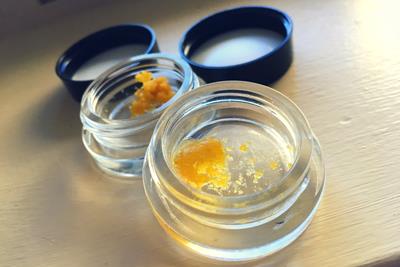
Thursday November 2, 2017
By Andrew Ward
 420 Culture
420 Culture
If sales trends continue in their current direction, then cannabis concentrates are destined to become the dominant figure in the market. In fact, over the past year, concentrate sales rose more than 50%. Conversely, flower sales declined in most markets, forcing cannabis businesses to sell flower cheaper on both wholesale and retail levels. While it was certainly expected that the market would introduce flower alternatives, this shift came as somewhat of a surprise.
The concentrates marketplace has been an ongoing evolution since vaping devices became smaller and more affordable. Today, vape cartridges are one of the cannabis market’s most popular items. In states like Washington, flower sales fell from 87% to 61% in just two years of sales. Meanwhile, edibles are on the rise. In California, the cannabis delivery service Eaze reported a 400% increase in oil cartridge purchases between 2015 and 2016 -- totaling 25% of the company’s total sales.
And that’s just the beginning. More products enter the market each year while flower cultivators and sellers wonder what’s next. Could a wide variety be the cannabis market’s most synonymous product’s demise?
The answer is no. A broad range of goods isn’t enough to topple flower sales entirely. Products have existed for nearly as long as flower has been sold. So, why are concentrates rocketing up the sales charts while purchasing flower appears almost as antiquated as Jeff Sessions’ views on marijuana? That answer is a bit more intricate.
Diverse Cannabis Concentrate Product Offerings
The concentrates sector is ripe with evolution and options for consumers. From high-end products to cost-efficient quality highs, the market now offers just about any product for any person – and these evolutions are changing how we consume cannabis.
Both recreational and medicinal clients are switching to concentrates. Many patients prefer dabbing and vape pens for a more discreet way to treat their ailments. Additionally, as more seniors become marijuana consumers, capsules are increasingly in demand.
In addition to the aforementioned, some of the market’s most popular products include:
Shatter
One of the most well-known concentrates on the market, shatter gets its name from its production process and consistency. Over the years, shatter has become increasingly refined. Many processers choose to de-wax their shatter nowadays, resulting in a clean and stable end product. True shatter should snap and break like hard candy and be a clear, yellow-amber hue.
Live Resin
Live resin is known by many names and is arguably the most popular product on the market. Live resin typically has a high terpene content and strong aroma, making it a very appealing product to smell and admire. Recently, extractors have improved their technology and are creating products with high crystalline content and high terpene content, sometimes referred to as sauce. These products resemble amber diamonds and are great for macro photography.

Essentially, live resin is made from fresh-frozen plant material that is blasted with solvent in a closed-loop system. From there, several refinement techniques are implemented to purge solvents and purify the end product.
Distillate
Distillate is another newer product on the market boasting superior potency and purity. With some products coming in at up to 95 percent THC, cannabis distillate is perhaps the strongest form of hydrocarbon concentrate out there.
Made via numerous distillation techniques, distillate starts with crude hydrocarbon extract that is refined with high heats, resulting in a clean, solvent-free end product – meaning solvents were used during initial extraction but have since been removed completely.
Because the distillation process is dependent on heat, terpenes are lost in the refinement process. Many companies will perform a terpene separation prior to distillation and reintroduce them back into the finished product or simply purchase plant-based terpenes. The change in the chemical structure and reintroduction of terpenes has been a topic for debate surrounding distillate, as many connoisseurs argue a full-spectrum experience is lacking.
Rosin
Another relative newcomer, rosin is one of the most DIY-accessible concentrates on the market today – though, a higher end market is opening up as well. Rosin is quickly becoming a premium extract sought-after by all types of consumers. And because no solvents are used in the process, many consumers believe rosin to be the healthiest concentrate option on the market.

The rosin making process includes high heat and high pressure to separate cannabinoids from plant matter. The end result is a quality, solventless extract that packs a potent punch. Depending on heat, pressure and duration settings, rosin can take many different forms ranging from saucey to more buddery/waxy consistencies.
The Market Value of Cannabis Concentrates
It isn’t just the wow factor of a new product hitting the marketplace that’s causing a shift. From a business standpoint, concentrates are becoming more appealing because of their large margins and higher retail price points.
With wholesale flower prices hitting an all-time low in Colorado and decreasing price trends in other established legal markets like Oregon and Washington, more and more companies are turning to concentrates to yield higher returns on their grows. Couple that with the increased consumer demand for high-end concentrates and it’s a no brainer why many companies are diverting focus towards concentrate sales.
As more and more mature cannabis markets begin to take hold and flower prices continue to decline, there will undoubtedly be a stronger push for concentrate sales as growers and dispensaries try to make the most out of their harvests.
If cultivators can no longer make good money on flower, the obvious choice is to turn to concentrates.
Of course, flower sales will always be around as many consumers still stick to traditional methods of consumption – but the margins may become razor thin for cultivators sooner than later.
Concentrates Are More Economical
From a consumer standpoint, concentrates are quite appealing for their quick relief and economical usage. Many consumers report using significantly less concentrates to feel desired effects when compared to traditional flower consumption. This allows for more relief and less time spent on actual consumption.
Additionally, many consumers are able to conserve concentrates much longer than flower. Heavy consumers may go through concentrates a bit faster, but for the average consumer a gram of concentrate can last longer than an eighth of flower.
Although concentrates typically sell at a higher price per gram than flower, the effectiveness and high cannabinoid content make up for the differential. Just take a look at the infographic below.
As you can see, the price per milligram of THC in concentrates is comparable, and actually cheaper in some circumstances than flower, making the higher price point justifiable. One could even make the argument that a consumer can save money by purchasing concentrates over flower (depending on the average price in their respective market).
On top of the economical application, consumers also cite health reasons for choosing concentrates. They cite a range of points from smoke allergies to feeling anxious to experiencing a cleaner high from concentrates.
Claims of cleaner highs to avoid carcinogens from burning marijuana have not yet been verified. However, consuming a concentrate is achieved through vaporization which is known to be a healthier option due to the lack of smoke. Meanwhile, some circles consider moving on from flower to concentrates as a somewhat rite of passage in the cannabis community.
Why Concentrates?
As mentioned, concentrates sell at a significantly higher sticker price. Additionally, the flower market has been facing saturation issues since California’s decriminalization days in the mid-1990s. This is causing cultivators to create better products at lower prices. Dispensaries lose revenue as well. However, with concentrates, their return on investment vastly improves.
For both businesses and consumers, going the concentrate route makes more sense than flower.
It only makes sense to move in the direction of concentrates as more consumers and companies get into the market. States are reporting massive gains in concentrate sales while flower is on the sharp decline. It’s unlikely that this will go on forever, but market upside indicates that this trend could last for some time.
As an increasing number of businesses enter the race for the purest products, only time will tell which concentrate tops the purity mountain. Regardless of what it is, expect to see even more innovations and evolutions hitting the concentrates market in the years to come.
Do you enjoy concentrates? Why or why not?








